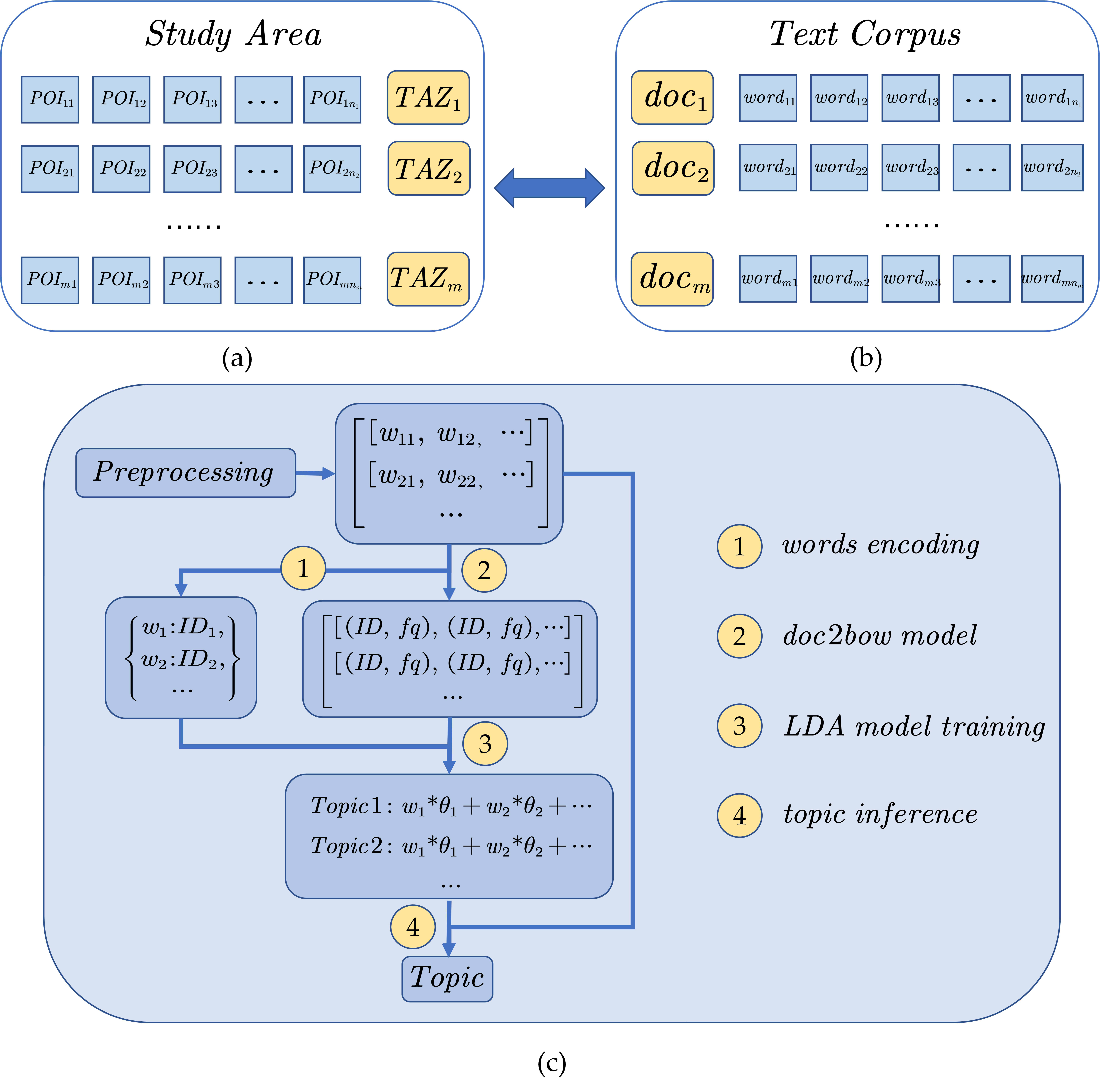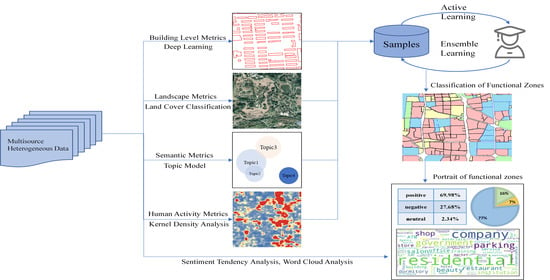1. Introduction
According to people’s different social and economic activities, cities are divided into different functional zones, which are the basic units of urban planning, management, and resource allocation [
1,
2,
3,
4,
5,
6]. The accurate mapping of functional zones is of great significance for the quantitative analysis of urban traffic, the balance of workplaces and residences, and residents’ relocation [
7], which are also helpful to economic and demographic research [
8,
9]. In traditional urban planning, urban functional zones are first planned and then constructed, and the distribution of functional zones must follow rules. However, it is difficult to replan and construct built-up areas in many large and medium-sized cities. At the same time, the division of urban functional zones formulated by the government usually takes administrative divisions as the unit, which only indicates the functional distribution on a macro level. In this case, the accurate division of fine-scale urban functional zones in existing built-up areas is of great significance to the understanding and management of cities.
In previous studies that have examined the research unit of fine-scale functional zones, the partitioning of functional zones involves the problem of modifiable area units [
10], so it is necessary to determine the division scale of functional zones before describing their categories. In the literature [
11], the methods for dividing functional zone units are summarized into three types: grid-based methods, block-based methods, and cadastral data-based methods. Grid-based methods usually create fishnets that cover the study area according to a certain space interval and then determine their functional attributes [
12,
13]. This segmentation method is simple and easy to operate, but the boundary obtained is not accurate. A grid may contain multiple functional zones, or a functional zone may be segmented by multiple grids. Block-based methods divide functional zones by road networks and then analyze the functional attributes of these traffic analysis zones (TAZs) [
2,
7,
14,
15,
16]. Road networks usually come from the popular collaborative mapping project OpenStreetMap (OSM) or the navigation data of Internet maps. These TAZs are more in line with the urban planning units, but the simple qualitative analysis of functional categories in previous studies cannot help urban planners obtain a good understanding of functional zones. The cadastral data-based methods use the land parcel in cadastral surveys as the unit of functional zone identification [
17]. Cadastral data are detailed and accurate, but they are slow to update and sometimes difficult to obtain [
18]. In recent years, there have been studies on functional zones based on segmentation units. These studies usually use object-oriented segmentation methods to obtain functional objects and study functional zones on a more precise scale [
11,
19]. However, the concept of functional zones implies highly heterogeneous and complex scenes [
1,
20,
21]. Functional zones are a combination of various land cover types with complex visual characteristics. Image segmentation produces objects with similar spectral and texture features rather than areas with homogeneous social functions, which is more meaningful in land cover and land use classification [
14,
22]. Functional zones should not correspond to a single land use type but should be a combination of land use and land cover types to provide functional services for people’s daily lives. Therefore, the research unit of this paper is based on TAZs, which are relatively fine and consistent with the planning unit of urban planning.
From the perspective of data and methods, image data and location-based social perception data are the main data sources suitable for urban functional area research. Very high-resolution (VHR) remote sensing images provide a wide and detailed view for the recognition of urban functional zones [
1,
23,
24]. The buildings in the image are clearly visible, and the land cover is immediately apparent. By using high-resolution remote sensing data as a single data source, Zhou et al. proposed a super object convolutional neural network based on super objects from image segmentation. The functional attributes of super objects were determined by voting on the functional categories of random points in them [
11]. However, most remote sensing images are focused on the natural characteristics of land cover, with abundant spectral and texture information and a lack of information on human and social activities [
7]. Therefore, in functional zone studies, remote sensing images are usually combined with other types of data to conduct research. With the development of information technology and the construction of smart cities, new urban social perception big data and corresponding data mining methods are emerging. Point of interest (POI) data are one of the most common types of data in the study of functional zone identification. POI data are widely used because of their accessible and rich semantic and land use information [
2,
25]. Zhang et al. proposed using public bicycle rental records and POI data to identify urban functional zones. The topic model and the unsupervised classification method are used to cluster the functional zones [
15]. Song et al. used VHR remote sensing images and POI data to calculate the function value of a TAZ by using building rooftop functional segments and the corresponding segmental weight coefficient [
7]. Chao et al. used social media check-in records and street view imagery to identify functional zones. Verbs in the check-in records are used to represent human activities, and street view data are used to represent the natural environment. The categories of urban functional zones are predicted based on deep learning [
26]. Mobile phone signaling data, a new type of human activity data, have also appeared in the study of urban functional zone recognition. Tu et al. studied the feasibility of hierarchical clustering by combining mobile phone positioning data and VHR remote sensing data to identify functional zones [
12]. In addition, real-time population heat map data, floating car trajectory data, and bus smart card data appear as human activity data in the study of functional area recognition [
13,
16,
27].
Generally, these studies on functional zones involve buildings, the natural environment, functional semantics, and human activities. Previous studies often establish the corresponding relationship between features and functional zones based on one point or parts of points but rarely comprehensively consider the characteristics of these four different aspects. In fact, all of these four aspects reflect the functions of zones. Functional zones are closely related to human activities. As the main space of human activities in the city, the shape of buildings must also conform to their functionality. In addition, landscape design is not only based on aesthetic or ecological considerations, but also closely related to its function. POIs are intuitive reflections of the functional zones. The above four metrics are directly related to the recognition of functional zones. The purpose of this paper is to comprehensively consider these four metrics of building, landscape, semantics, and human activities to complete the identification of urban functional zones. In addition, this paper also aims to optimize the other two aspects ignored in previous studies of functional zones: on the one hand, large-scale functional zone recognition application scenarios are different from small-scale experiments. One of the important differences is sample labeling. In small-scale experiments, all the training samples can be labeled in order to obtain better classification accuracy. However, large-scale application scenarios need to fully consider the cost of sample labeling. In the process of extending the method of small-scale experiments to large-scale application scenarios, how to balance the accuracy of identification and the cost of labeling is one of the problems that this paper attempts to solve. On the other hand, this paper tries to make portraits of urban functional zones. Previous studies stop at the recognition of functional zones’ categories, but categories are only the most basic information of functional zones. People’s emotions in the process of interaction with urban functional space, various types of POI, and the percentage of vegetation coverage can reflect the characteristics of functional zones from different aspects, which together form the portraits of functional zones.
Based on the above three objectives, a series of experiments are designed in this paper. This study contributes in three ways. First, this paper comprehensively describes the characteristics of urban functional zones in four different aspects, building-level metrics, landscape metrics, semantic metrics, and human activity metrics, and effectively identifies the categories of functional zones. Second, active learning is introduced in the process of sample labeling to balance the accuracy and the cost of sample labeling in large-scale urban functional zone recognition. Third, portraits of functional zones create a multiperspective description mode of functional zones.
5. Conclusions
This paper proposes a framework to quantitatively describe functional zones, identify functional zone categories, and draw functional zone portraits. With the characteristics of repeatability, comprehensiveness, and large-scale implementation, it describes the features of functional zones from multiple perspectives and realizes the accurate identification of functional zones based on the supervised ensemble learning algorithm XGBoost. Within the Fifth Ring Road, Haidian District, Beijing, the study area of this paper, experimental results fully prove the effectiveness of the method proposed in this paper. Based on the classification of functional zones, the method of sample labeling is optimized and the portraits of typical functional zones are drawn.
The contribution of this study is mainly concentrated in three aspects. First, this paper integrates multisource heterogeneous data and an ensemble learning method to effectively identify the categories of urban functional zones, and the overall recognition accuracy reaches 82.37%. Based on VHR remote sensing images, Internet map POI data, and real-time human activity density data, this study uses deep learning technology, the landscape ecological index calculation method, the NLP theme model, and the kernel density analysis method to sort out and calculate four kinds of metrics: building-level metrics, landscape metrics, semantic metrics, and human activity metrics. These four metrics describe urban functional zones comprehensively and lay a good foundation for the category identification. Compared with a single classifier method (random forest), the ensemble learning method (XGBoost) improves the overall classification accuracy by 14.62%. Second, considering the burden of sample labeling when expanding the method of functional zone identification from a small experimental area to a large-scale application, this paper proposes a sample labeling method based on active learning to balance the accuracy of identification and the cost of sample labeling. Compared with the random sampling method, it is found that the sampling method based on active learning effectively improves the identification accuracy of the functional zone with the same sample labeling burden. Third, this paper goes beyond the classification of functional zones by adding sentiment analysis, word clouds, and land cover proportion maps to the portraits of functional zones, making the image of functional zones clear at a glance. The functional zone portraits show the characteristics of the functional zones from multiple perspectives. Even if there are supplements of new source data in the future, the analysis results can be added to the portraits, so as to increase new perspectives of people’s cognition of functional zones.
The research framework of this paper involves the construction of a metrics system, sample labeling, ensemble learning, and category portraits. This framework can be transferred to some supervised classification scenarios. For example, land use and land cover classification. However, it is necessary to adjust the data source and metrics system according to the application scenarios to ensure good classification results.
The next step of our study will focus on how to integrate urban traffic big data into the research of urban functional zones to analyze the impact range of functional zones. Furthermore, it can also analyze the origin and destination of the people flow in the functional zones, and the results can help companies to reasonably arrange off-peak commuting, or help shopping malls to accurately formulate shopping shuttle routes.
















